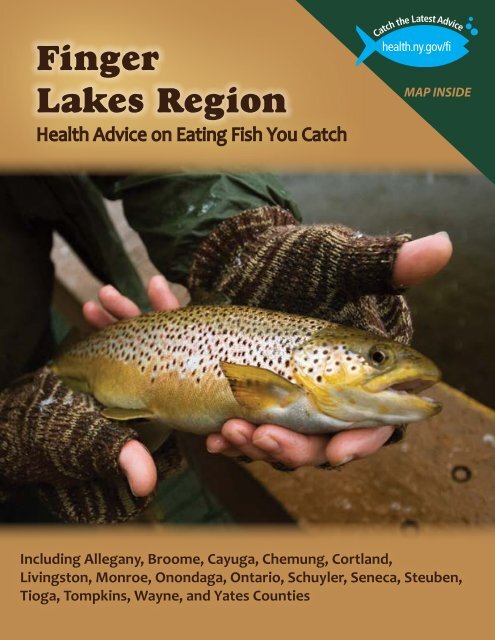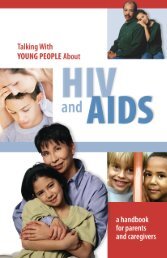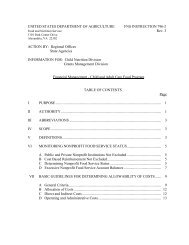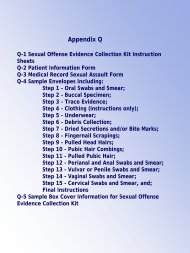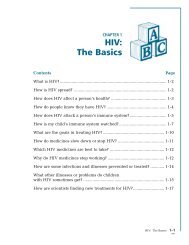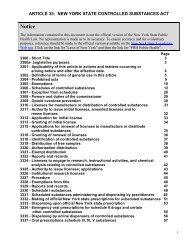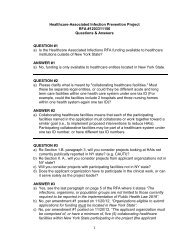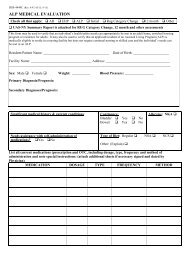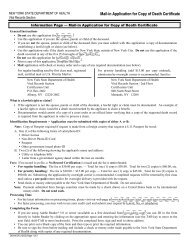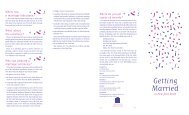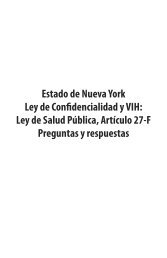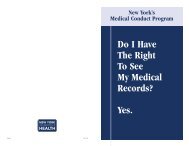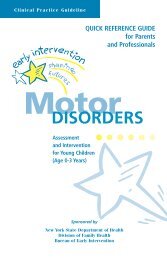Finger Lakes Region - New York State Department of Health
Finger Lakes Region - New York State Department of Health
Finger Lakes Region - New York State Department of Health
You also want an ePaper? Increase the reach of your titles
YUMPU automatically turns print PDFs into web optimized ePapers that Google loves.
<strong>Finger</strong><br />
<strong>Lakes</strong> <strong>Region</strong><br />
<strong>Health</strong> Advice on Eating Fish You Catch<br />
MAP INSIDE<br />
Including Allegany, Broome, Cayuga, Chemung, Cortland,<br />
Livingston, Monroe, Onondaga, Ontario, Schuyler, Seneca, Steuben,<br />
Tioga, Tompkins, Wayne, and Yates Counties
Why We Have Advice<br />
Fishing is fun and fish are an important part <strong>of</strong> a healthy diet. Fish<br />
contain high quality protein, essential nutrients, healthy fish oils<br />
and are low in saturated fat. However, some fish contain chemicals at<br />
levels that may be harmful to health. To help people make healthier<br />
choices about which fish they eat, the <strong>New</strong> <strong>York</strong> <strong>State</strong> <strong>Department</strong><br />
<strong>of</strong> <strong>Health</strong> issues advice about eating sportfish (fish you catch). The<br />
health advice about which fish to eat depends on:<br />
Where You Fish<br />
Fish from waters that are affected by industrial sources are<br />
more likely to be contaminated than fish from other<br />
waters. In the <strong>Finger</strong> <strong>Lakes</strong> region for example,<br />
fish from Cayuga Lake are generally less<br />
contaminated than fish from Lake Ontario and<br />
Onondaga Lake. This is because Cayuga Lake has<br />
been less affected by certain industrial chemicals.<br />
If you’re planning a fish meal, please read the section<br />
Where can the whole family eat the fish? inside this<br />
brochure.<br />
Some fish are known to move from lakes and rivers into tributaries,<br />
such as from Onondaga Lake into the Seneca River. The lake and<br />
river advice also applies to its tributaries up to the first barrier<br />
that stops fish from moving upstream, such as a dam or waterfall.<br />
Who You Are<br />
Women <strong>of</strong> childbearing age (under 50) and<br />
children under 15 are advised to limit the<br />
kinds <strong>of</strong> fish they eat and how <strong>of</strong>ten they<br />
eat them. Women who eat highly contaminated
fish and become pregnant may have an increased risk <strong>of</strong> having<br />
children who are slower to develop and learn. Chemicals may have<br />
a greater effect on the development <strong>of</strong> young children or unborn<br />
babies. Also, some chemicals may be passed on in mother’s milk.<br />
Women beyond their childbearing years and men may face fewer<br />
health risks from some chemicals. For that reason, the advice for<br />
women over age 50 and men over age 15 allows them to eat more<br />
kinds <strong>of</strong> sportfish and more <strong>of</strong>ten (see inside table).<br />
What You Catch<br />
There is specific advice about limiting or not eating<br />
certain kinds <strong>of</strong> fish in some <strong>of</strong> this region’s<br />
waterbodies (see inside table). Some fish have<br />
higher levels <strong>of</strong> chemicals than others. In general,<br />
smaller fish are less contaminated than larger, older<br />
fish <strong>of</strong> the same species. You can also choose to<br />
eat fish from waters not listed in the inside table and<br />
follow the general advice to eat up to four meals per month.<br />
<strong>Health</strong> Risks<br />
The primary chemicals <strong>of</strong> concern in the <strong>Finger</strong> <strong>Lakes</strong> region are PCBs,<br />
dioxin, mirex and mercury. These chemicals build up in your body<br />
over time. <strong>Health</strong> problems that may result from chemicals in fish<br />
range from small changes in health that are hard to detect to birth<br />
defects and cancer. (Visit www.health.ny.gov/fish for more info.)
COMMON FISH OF THE<br />
FINGER LAKES REGION<br />
Brook trout<br />
Brown bullhead<br />
Tips for <strong>Health</strong>ier Eating<br />
• Try to space out your fish meals. For<br />
example, if the advice is that you can<br />
eat up to four meals a<br />
month, don’t eat them all<br />
in the same week. This<br />
is particularly important<br />
for women and young<br />
children.<br />
One meal = ½ pound<br />
• Bacteria, viruses or parasites may<br />
be in or on fish. Keep harvested fish<br />
cold. Wear gloves when skinning and<br />
trimming. Wash hands and surfaces<br />
<strong>of</strong>ten when preparing fish, and keep raw<br />
foods separate. Cook fish and shellfish<br />
thoroughly before eating.<br />
Brown trout<br />
Tips to Reduce PCBs, Dioxin, and Mirex<br />
Carp<br />
Chain pickerel<br />
Channel catfish<br />
Chinook salmon<br />
• PCBs, dioxin and mirex are found at higher<br />
levels in the fat <strong>of</strong> fish. Reduce fat by<br />
properly trimming, skinning and cooking<br />
your catch:<br />
• Cooking or soaking fish cannot eliminate<br />
the chemicals, but heat from cooking<br />
melts some <strong>of</strong> the fat. Broil, grill or<br />
bake the trimmed, skinned fish on a rack<br />
so that the fat drips away. Do not use<br />
drippings in sauces or gravies.<br />
• To reduce exposures to PCBs, dioxin, and<br />
mirex avoid or eat less carp, channel<br />
catfish, lake trout, salmon (chinook,<br />
coho), and white perch because these<br />
fish tend to have higher levels <strong>of</strong> these<br />
contaminants.<br />
Coho salmon<br />
Lake trout<br />
Largemouth bass<br />
Northern pike<br />
Tips to Avoid Mercury<br />
• The only way to reduce how much mercury<br />
you get from fish is to avoid certain<br />
species or eat less contaminated fish.<br />
• To reduce exposures to mercury, avoid or<br />
eat less largemouth and smallmouth bass,<br />
northern pike, pickerel, walleye and larger<br />
yellow perch (for example, longer than 10<br />
inches) because these fish tend to have<br />
higher mercury levels.<br />
• Mercury is distributed throughout a fish’s<br />
muscle tissue (the part you eat), rather<br />
than in the fat and skin. Trimming and<br />
skinning will not reduce the amount <strong>of</strong><br />
mercury in a fish meal.<br />
Pumpkinseed/Sunfish<br />
Rainbow trout<br />
Rock bass<br />
Smallmouth bass Walleye White perch White sucker Yellow perch
Location & Tributaries<br />
(Chemical <strong>of</strong> Concern)<br />
Fish<br />
Men Over 15 &<br />
Women Over 50<br />
Women Under 50 &<br />
Children Under 15<br />
All waters NOT listed<br />
(<strong>Finger</strong> <strong>Lakes</strong> <strong>Region</strong>)<br />
Canadice Lake (PCBs)<br />
All fish Up to 4 meals/month Up to 4 meals/month<br />
Lake trout<br />
Greater than 23", DON'T EAT;<br />
Less than 23", up to 1 meal/month<br />
DON'T EAT<br />
Brown trout Up to 1 meal/month DON'T EAT<br />
All other fish Up to 4 meals/month DON'T EAT<br />
Chenango River (Mercury)<br />
Irondequoit Bay<br />
(PCBs, Mirex, Dioxin)<br />
Keuka Lake (DDT)<br />
Koppers Pond (PCBs)<br />
Lake Ontario *<br />
(PCBs, Mirex, Dioxin)<br />
Walleye<br />
Greater than 22", up to 1 meal/month;<br />
Less than 22", up to 4 meals/month<br />
DON'T EAT<br />
All other fish Up to 4 meals/month DON'T EAT<br />
Same advice as Lake Ontario<br />
Lake trout<br />
Greater than 25", up to 1 meal/month;<br />
Less than 25", up to 4 meals/month<br />
DON'T EAT<br />
All other fish Up to 4 meals/month DON'T EAT<br />
Carp Up to 1 meal/month DON'T EAT<br />
All other fish Up to 4 meals/month DON'T EAT<br />
Lake trout<br />
Coho salmon<br />
White perch<br />
Greater than 25", DON’T EAT;<br />
Less than 25", up to 1 meal/month<br />
Greater than 25", up to 1 meal/month;<br />
Less than 25", up to 4 meals/month<br />
Up to 1 meal/month<br />
(West <strong>of</strong> Point Breeze, DON’T EAT)<br />
DON'T EAT<br />
DON'T EAT<br />
DON’T EAT<br />
Chinook salmon, Rainbow trout, White sucker Up to 1 meal/month DON'T EAT<br />
Carp, Channel catfish DON'T EAT DON'T EAT<br />
Brown trout<br />
Greater than 20", DON'T EAT;<br />
Less than 20", up to 1 meal/month<br />
DON'T EAT<br />
All other fish Up to 4 meals/month DON'T EAT<br />
Onondaga Lake<br />
(PCBs, Mercury, Dioxin)<br />
Rushford Lake<br />
(Mercury)<br />
Seneca River Downstream <strong>of</strong> Lock<br />
24 at Baldwinsville<br />
(PCBs, Mercury, Dioxin)<br />
Skaneateles Creek From Dam<br />
at Skaneateles to Seneca River<br />
(PCBs)<br />
Susquehanna River<br />
(Mercury)<br />
Largemouth bass, Smallmouth bass<br />
1<br />
Greater than 15", DON'T EAT;<br />
Less than 15", up to 1 meal/month<br />
DON'T EAT<br />
Carp, Channel catfish, White perch, Walleye DON'T EAT DON'T EAT<br />
Brown bullhead, Pumpkinseed Up to 4 meals/month DON'T EAT<br />
All other fish Up to 1 meal/month DON'T EAT<br />
Walleye Up to 1 meal/month DON'T EAT<br />
All other fish Up to 4 meals/month DON'T EAT<br />
Same advice as Onondaga Lake<br />
Brown trout<br />
Greater than 10", up to 1 meal/month;<br />
Less than 10", up to 4 meals/month<br />
DON'T EAT<br />
All other fish Up to 4 meals/month DON'T EAT<br />
Walleye<br />
Greater than 22", up to 1 meal/month;<br />
Less than 22", up to 4 meals/month<br />
DON'T EAT<br />
All other fish Up to 4 meals/month DON'T EAT<br />
* Harvest/possession <strong>of</strong> American eel is prohibited per DEC Regulations
Tonawanda<br />
Creek<br />
Oak Orchard<br />
Creek<br />
Oatka<br />
Point Breeze<br />
Creek<br />
Erie Canal<br />
Genesee River<br />
Conesus Lake<br />
Hemlock Lake<br />
Honeoye Lake<br />
Lake Ontario<br />
Erie Canal<br />
Canandaigua Lake<br />
Keuka Lake<br />
Seneca Lake<br />
Chemung<br />
Seneca<br />
River<br />
Cayuga Lake<br />
River<br />
Oswego<br />
Owasco Lake<br />
Oswego River<br />
Skaneateles<br />
Creek<br />
Otisco Lake<br />
Skaneateles Lake<br />
OSWEGO<br />
Sodus<br />
Albion<br />
Irondequoit<br />
Bay<br />
ORLEANS Bay<br />
Rochester<br />
WAYNE<br />
Cross Baldwinsville<br />
MONROE Lake<br />
GENESEE<br />
Lyons<br />
Onondaga Lenox<br />
Lake<br />
Warsaw<br />
Batavia<br />
WYOMING<br />
Rushford<br />
Lake<br />
Geneseo<br />
ALLEGANY<br />
LIVINGSTON<br />
Canadice Lake<br />
ONTARIO<br />
Bath<br />
Canandaigua<br />
YATES<br />
Penn Yan<br />
Waterloo<br />
SCHUYLER<br />
SENECA<br />
Watkins Glen<br />
Auburn<br />
CAYUGA<br />
TOMPKINS<br />
Belmont STEUBEN Koppers TIOGA<br />
Pond<br />
CHEMUNG<br />
Elmira<br />
Ithaca<br />
Syracuse<br />
Dam at Skaneateles<br />
ONONDAGA<br />
Cortland<br />
CORTLAND<br />
Susquehanna River<br />
Owego<br />
Oneida Lake<br />
Chenango<br />
Binghamton<br />
ONEIDA<br />
MADISON<br />
CHENANGO<br />
River<br />
BROOME<br />
Norwich<br />
What about tributaries and connected waters?<br />
The specific advice in the table applies to tributaries and connected waters if there are no dams, falls or barriers to stop the<br />
fish from moving upstream. This is because chemicals remain in fish when they move from one waterbody to another.<br />
If you are not sure about possible fish barriers near waters where you are fishing, call your DEC <strong>of</strong>fice listed on the back <strong>of</strong><br />
this brochure.<br />
Where can the whole family eat the fish?<br />
The <strong>Finger</strong> <strong>Lakes</strong> region has great fishing. Everyone in the family can follow the general advice and enjoy up to four fish<br />
meals a month from any waters in this region not listed in the table, such as:<br />
• Cayuga Lake • Otisco Lake<br />
• Hemlock Lake • Seneca Lake<br />
• Honeoye Lake • Skaneateles Lake<br />
These lakes are just examples <strong>of</strong> fishing spots where the four meals a month general advice applies. The DEC fishing website<br />
listed on the back <strong>of</strong> this brochure has a wealth 2 <strong>of</strong> resources to help you find public access fishing sites, boat launches, and<br />
license information. It also includes information on what types <strong>of</strong> fish are found in different waterbodies across <strong>New</strong> <strong>York</strong>.<br />
Remember to check for specific advice like that listed in the table if you plan on eating the fish you catch. If you have<br />
questions about health advice for your favorite waterbody call the fish advisory team at (518) 402-7800.<br />
Visit www.health.ny.gov/fish for the latest advice about eating your catch for all regions in the state.
Fish from Stores and Restaurants<br />
The US Food and Drug Administration (FDA) regulates the<br />
sale <strong>of</strong> commercial fish in markets. Due to concerns about<br />
mercury, FDA advises pregnant women, women who may<br />
become pregnant, nursing mothers and young children to<br />
avoid shark, swordfish, king mackerel and tilefish.<br />
Food and Drug Administration: (888) SAFEFOOD, (888) 723-3366<br />
More Information<br />
<strong>New</strong> <strong>York</strong> <strong>State</strong> Fish Advisories<br />
<strong>Department</strong> <strong>of</strong> <strong>Health</strong><br />
www.health.ny.gov/fish<br />
(518) 402-7800<br />
(800) 458-1158<br />
email BTSA@health.state.ny.us<br />
Other Fish Information<br />
Environmental Protection Agency<br />
www.epa.gov/ost/fish<br />
Food and Drug Administration<br />
www.fda.gov/Food/ResourcesForYou/<br />
Consumers/ucm110591.htm<br />
<strong>New</strong> <strong>York</strong> <strong>State</strong> Fishing<br />
<strong>Department</strong> <strong>of</strong> Environmental<br />
Conservation (DEC)<br />
www.dec.ny.gov/outdoor/fishing.html<br />
<strong>New</strong> <strong>York</strong> <strong>State</strong> Fishing, cont.<br />
DEC <strong>Region</strong> 7<br />
(Broome, Cayuga, Cortland, Onondaga,<br />
Tioga, and Tompkins counties)<br />
Cortland Office<br />
(607) 753-3095<br />
DEC <strong>Region</strong> 8<br />
(Chemung, Livingston, Monroe, Ontario,<br />
Schuyler, Seneca, Steuben, Wayne and<br />
Yates counties)<br />
Avon Office<br />
(585) 226-5343<br />
DEC <strong>Region</strong> 9<br />
(Allegany county)<br />
Allegany Sub-Office<br />
(716) 372-0645<br />
2768<br />
<strong>New</strong> <strong>York</strong> <strong>State</strong> <strong>Department</strong> <strong>of</strong> <strong>Health</strong> 4/13


